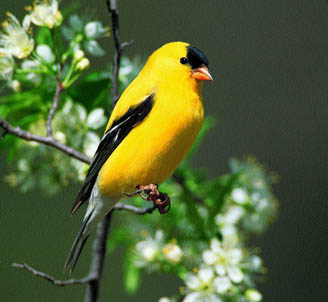
The American Goldfinch is one of the most colorful and conspicuous song birds. It is often called the Wild Canary because the male, except for his black forehead, wings and tail, is bright lemon yellow and has such a sweet ecstatic song. It is a bird of the open places and so fond of companionship that, except while nesting, they are usually seen in flocks and, like robins, have little fear of people. The finch is attracted to thistle and will come to a thistle feeder, many times in groups.
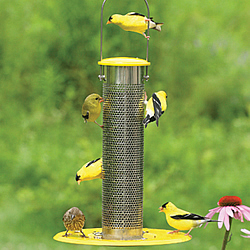
ATTRACTING AND FEEDING THE GOLDFINCH
- The goldfinch likes nyjer thistle seed, so providing a reliable thistle feeder will encourage them to come to your yard. To test if nyjer thistle seed is fresh, press between the heel of two spoons and look for an oil secretion.
- The gold finch usually lines its nest with thistledown, so provide a nesting material such as Best Nest Builder, to lure them near your feeder and encourage them to build their nests nearby. They usually do not build in birdhouses.
- Goldfinches like the color yellow, so purchase a thistle feeder with some yellow on it, or tie a yellow ribbon or deflated balloon nearby.
- Finches like to move in flocks, so provide a feeder with several ports to accommodate larger groups.
- The American Goldfinch usually nests in July and August, later than most species, so don't worry if they disappear for several weeks. Be patient, and they may return if you continue to provide fresh seed.
GETTING TO KNOW THE GOLDFINCH
The goldfinch belongs to the largest family of birds which includes the towhees, grosbeaks, buntings, our native sparrows, cardinals, and other finches. All of them have short stout cone-shaped bills and are primarily seed eaters. In spring the goldfinch eats the seeds of last year's weeds, the tender buds of trees and shrubs, and many small insects. In summer and fall, when the fields are crowded with dandelions, thistles, asters, goldenrod, and weeds, it feeds mostly on seeds.
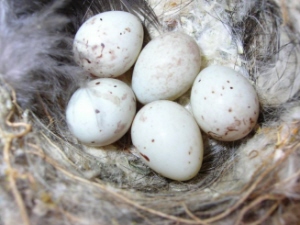
Of all American birds, except for those that raise a second brood in summer,the goldfinch is the last to nest and raise a family. Very few nests are started before July and the number being built, or containing eggs or young, reaches its peak about the middle of August. The compact cup-shaped nest is constructed of the silky fibers of milkweeds and fine grasses or strips of bark from weeds, and usually lined with thistledown.
The goldfinch song is a long series of twittering and warbling notes. Common contact call a "tsee-tsi-tsi-tsit," often given in flight. May be described as "per-chic-o-ree" or "po-ta-to-chip."
Listen to Call
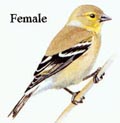
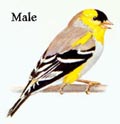
INDENTIFICATION OF THE GOLDFINCH
- Size: 11-13 cm (4-5 in)
- Wingspan: 19-22 cm (7-9 in)
- Weight: 11-20 g (0.39-0.71 ounces)
- Small bird
- Bill small, pointed, conical, and pink
- Body bright yellow to dull brown
- Wings dark with large white wingbars
- Tail short and notched
- Breeding male bright yellow with black cap and wings.
- Eyes black.
- Undertail white.
- Flies with bouncing flight.
- Calls frequently in flight.
- Usually found in small flocks.
Summer Range of the Goldfinch:
Breeds across continent from central Canada southward to northern Nevada, Oklahoma, and central Georgia.
Winter Range of the Goldfinch:
Winters from Canadian border southward to southern United States and into Mexico.
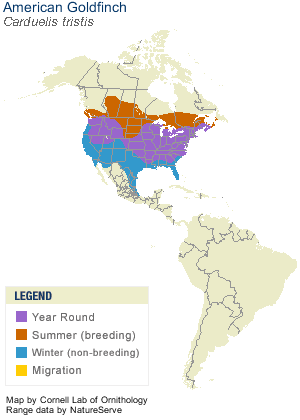
FUN FACTS ABOUT THE GOLDFINCH
- The American Goldfinch changes from winter plumage to breeding plumage by a complete molt of its body feathers. It is the only member of its family to have this second molt in the spring; all the other species have just one molt each year in the fall.
- The American Goldfinch is one of the latest nesting birds. It usually does not start until late June or early July, when most other songbirds are finishing with breeding. The late timing may be related to the availability of suitable nesting materials and seeds for feeding young.
- The American Goldfinch is gregarious throughout the year. In winter it is found almost exclusively in flocks. In the breeding season it feeds in small groups. Whether it maintains breeding territories is debatable.
- In winter, both the male and female lose the bright yellow color and have a more brownish overall color.
- The American Goldfinch is mostly monogamous, but a number of females switch mates after producing a first brood. The first male takes care of the fledglings while the female goes off to start another brood with a different male.
- The American Goldfinch is the state bird of New Jersey, Iowa, Minnesota and Washington.
Sources: Cornell Lab of Ornithology, and The Birds of North America